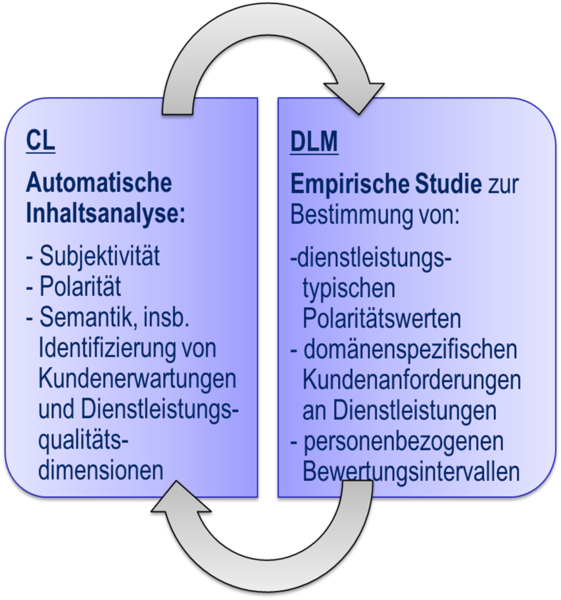More than Words
Analysis of user-generated content to identify latent service quality characteristics
Short Facts
| Project Duration: | October 2013 to December 2014 |
| Project Leadership: | Jun.-Prof. Dr. Michaela Geierhos & Prof. Dr. Nancy V. Wünderlich |
| Promotion Program: | Paderborn University Research Award 2013 |
| Level of Funding: | 62.000 € |
Motivation - Why is there a need?
Internet users have more and more opportunities to review a variety of products (e.g. Amazon Reviews), services (e.g. MyHammer, jameda) and experiences (e.g. TripAdvisor). Users visit review sites to actively share their experiences with services such as hotel holidays, visits to the doctor or mail order experiences with interested other customers. For many consumers, these ratings are a helpful source of information for weighing up a personal purchase decision. The increasing flood of ratings and reviews on rating sites (e.g. ShopVote) and social media (e.g. qype, flickr), however, also confronts Internet users with the challenge of selecting the large number of rating comments and websites with regard to their relevance. These ratings often consist of free texts (so-called user-generated content), which can differ significantly in structure and content focus. In particular, if these free texts form the only basis for evaluation, an interpretation hurdle is emerging on the user side. If measurable user evaluations are available in the form of scales, they are often not always consistent with the freely formulated rating comments. While there are various software solutions that allow companies to automatically analyze the opinions of their customers (e.g. TrustYou) and thus follow trends, the user himself has no tool at hand that supports him in assessing the service quality of a company at first glance in millions of ratings.
Innovation - What is being developed?
A new interdisciplinary correlative method, ...
which can draw conclusions about domain-specific customer requirements for services and user-specific deviations in polarity through computer-linguistic methods for semantic content analysis of review texts in Web 2.0;
which compares empirically determined dimensions of service quality instead of domain-independent SERVQUAL categories in relation to qualitatively and quantitatively measurable customer satisfaction;
which for the first time enables an automatic comparison of qualitative and quantitative service ratings by taking into account the user-typical rating intervals for polarity scales.
Implementation - How does interdisciplinarity lead to the goal?
The aim of the research project is to implement the above scenario using methods of Computational Linguistics (CL) and Service Management (SM). The following research questions are addressed based on the research gaps in both disciplines:
- To what extent do the authors of rating comments use characteristics that correspond to the classical rating dimensions of service quality to describe service experience? To what extent are other evaluation criteria and dimensions used?
- To what extent do users' rating comments vary? Which rating behavior is recognizable? To what extent are there differences for different service areas?
- If quantitative scales are used: Does the addition of free text ratings help to determine scale equivalence? To what extent do the qualitative rating comments match the overall quantitative ratings - under what conditions do they differ?
Project Presentations
| Date | Title | Conference |
|---|---|---|
| 01/24/2014 | Identifying perceived service quality dimensions in patients’ online reviews | 1. Passauer Digital-Marketing-Konferenz - [PDF] |
Media
| Date/Issue | Title | Source |
|---|---|---|
| 05.03.2015 | „More than Words“ – Vereinfachte Analyse von Arztbewertungen | Pressemitteilung des Heinz Nixdorf Instituts |
| 1/2014, S.32 | Was die Menschen bewegt: Neue Wege der semantischen Bewertungstextanalyse | PUZ - Paderborner Universitätszeitschrift |
| 17.02.2014 | Neues Forschungsprojekt zu Bewertungseiten im Internet | WDR5 |
| 30.01.2014 | “People going to the same party share common characteristics”. Ein Recap der 1. Passauer Digital-Marketing-Konferenz. | IntelliBlog |
| 2013 | More than Words“: Analyse von User Generated Content zur Identifikation von latenten Dienstleistungsqualitätsmerkmalen | HNI Jahresbericht 2013 |



